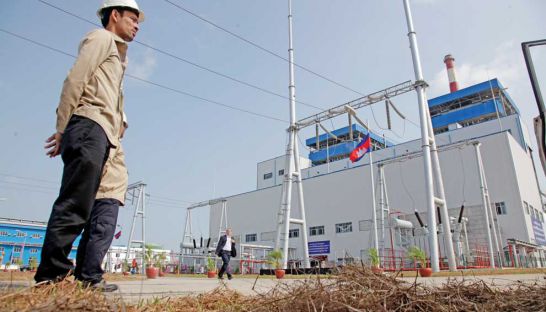Coal outgrows hydropower
Coal outgrows hydropower
As Cambodia’s demand for electricity grows and domestic energy production increases, new data released from the Ministry of Mines and Energy yesterday show that coal-fired energy generation surpassed hydroelectricity for the first time last year.

According to the Cambodia National Energy Statistics 2016, a joint publication issued by the Ministry of Mines and Energy (MME) and The Economic Research Institute for ASEAN and East Asia (ERIA) – a regional think tank – coal-fired power generation eclipsed hydroelectricity as the dominant source for the Kingdom’s domestic energy supply.
Fuelled by two coal-fired plants, the CIIDG Erdos Hongjun Electric Power 270-megawatt facility, which is co-owned by Cambodian People’s Party Senator Lao Meng Khin, and the neighbouring 100-megawatt plant owned by Malaysia’s Leader Universal Holdings in Preah Sihanouk province, coal produced a total of 2,376 gigawatt hours last year. This is nearly a three-fold increase from the 863 gigawatt hours produced in 2014.
Meanwhile, hydropower produced nearly 2,000 gigawatt hours last year, a slight increase from 1,851 gigawatt hours in 2014. The report noted that while the Kingdom still imported nearly 1,541 gigawatt hours of electricity from neighbouring countries last year, the overall trend was that the Kingdom was weaning itself off of foreign power. The Kingdom as a whole produced 6,186 gigawatt hours in 2015.
Han Phoumin, an energy economist for the ERIA, said that while the Cambodian government was still pursuing hydropower for core energy production, the rise of coal was to fulfil short-term demand and to backup underperforming hydropower plants in the future.
“Hydropower and coal will be the major sources of energy for Cambodian electricity for now and in the future,” he said. “Coal will be largely used to cover the load demand during the dry season because hydropower electricity production is expected to reduce due to seasonal fluctuations.”
He added that coal-fired power plants are cheap and easy to build. “Coal-fired power generation is economically feasible and is affordable and provides stable energy supply in terms of energy security,” he said.
However, with increased domestic production, he said the government needs to focus on strengthening and expanding its national grid.
“The challenges are to speed up the national grid expansion and investment in this sector. So the coordination of national grids and power plants are needed to ensure that all completed power plants can transmit electricity to final users,” he said.
Kung Phoak, co-founder and president of the Cambodian Institution for Strategic Studies (CISS), said that the government needed to do everything it could to shore up energy security, regardless of the power source, to keep the economy competitive.
“Electricity is one of the key factors that define the price of goods that are produced in Cambodia,” he said. “More electricity produced locally and less dependency on imports is a great movement for the country.”
He added that coal-fired plants would play a crucial role in the future and that coal was both cheap and a reasonable option for a developing country.
However, Stephen Higgins, managing partner of investment firm Mekong Strategic Partners, said that while coal plants can be built more quickly than hydropower dams, the government needs to take into account the amount of air pollution they emit.
“From an environmental perspective, does Cambodia really want its beach destinations suffering from the pollution from coal-fired power stations?” he asked, adding that from an economic perspective coal is struggling to compete with the diminishing investment costs of renewable energy.
“Admittedly Cambodia is coming from a low base in terms of existing generation assets, but it still seems a little odd that it would put so much emphasis on coal generation,” he said, adding that the government could easily roll out an extensive solar generation strategy providing it put the proper regulatory framework in place.
Tun Lean, undersecretary of state for the Electricity Authority of Cambodia (EAC), previously told the Post that a third 135-megawatt unit would come online this month at the CIIDG plant. Additionally, Kith Meng’s Royal Group submitted a feasibility study for a 500-megawatt coal-fired plant to the government in June of this year.













